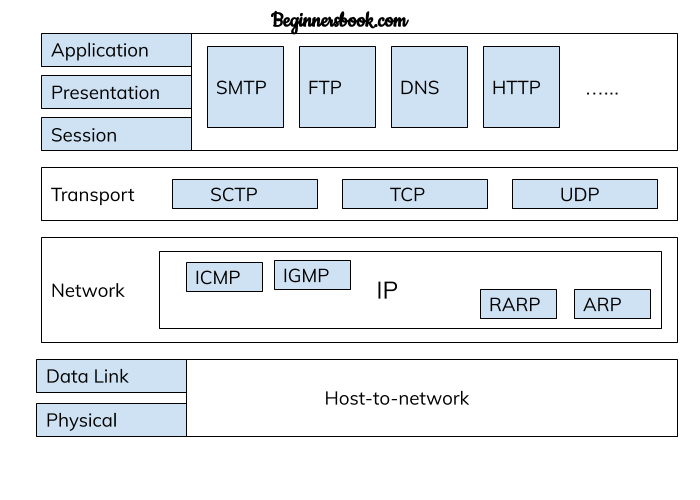The TCP/IP Model is developed before than OSI Model. The layers in TCP/IP Model are different than OSI Model. In this guide, we will discuss TCP/IP model and its layers in detail.
Layers in TCP/IP Model
The TCP/IP Model has four layers:
1. Physical Layer and data link layer – combined known as host-to-network layer
2. Network layer
3. Transport
4. Application

1. Physical and Data Link Layer
Physical and Data Link Layers in TCP/IP model does not define any protocols, they support all the standard protocols. They are combined known as host-to-network layer. A network in TCP/IP internetwork can be LAN or WAN.
2. Network Layer
In the network layer, the TCP/IP model supports internetworking protocol in short known as IP. The IP uses four protocols internally: ARP, RARP, ICMP & IGMP.
Internetworking protocol(IP):
1. It is an unreliable connectionless protocol used by TCP/IP Model.
2. This protocol is used for data transmission.
3. This protocol doesn’t do error checking or tracking of data, thus we cannot be sure that the data is actually reached its destination. This is why it is also known as best effort delivery service which means this protocol tries it best to send the data to its destination but doesn’t take an guarantee.
4. IP protocol transmits the data in form of small packets known as datagrams. Each of these datagrams are transmitted separately, thus they can take different routes and sometime duplicate datagrams can be reached to destination, also they are reached in no particular order at the destination.
Lets discuss the four protocol this Internetworking protocol(IP) uses:
Address Resolution Protocol (ARP)
ARP finds the physical address by using the IP address. In a network, each device is known as physical address usually imprinted on Network interface card (NIC).
ARP protocol is used to find the physical address of a device whose internet address (IP address) is known.
Reverse Address Resolution Protocol (RARP)
RARP protocol helps to find the internet address of a device whose physical address is known.
Internet Control Message Protocol (ICMP)
IP in network layer sends data in form of small packets known as datagrams. ICMP protocol sends the datagrams problems back to sender. It is used for query and error reporting messages.
Internet Group Message Protocol (IGMP)
This protocol is used for simultaneous transmission of a message to a group of recipients.
3. Transport Layer
Transport layer in TCP/Model can be represented by three protocols: Transmission control protocol (TCP), User data gram protocol (UDP) and Stream Control Transmission Protocol (SCTP).
These three protocols in transport layer are responsible for delivery of messages from one process to another. The SCTP protocol was later introduced to meet the needs of newer applications.
User Datagram protocol (UDP)
1. UDP is a process to process protocol used for data transmission.
2. It takes the data from upper layer of TCP/IP Model and adds following information to the data:
a) Port Address – Source port address of 16 bits and destination port address of 16 bits added to the data so that it reaches to correct destination and displays the correct source of data.
b) checksum error control – 16 bits of checksum data is added to the data received from upper layer, this is used for error control.
c) length of data – Length defines the total bytes of data in datagram.
3. Although this protocol finds the error in the transmission of data, it doesn’t specify the error which makes it hard to identify the actual error in transmission.
Transmission control protocol (TCP)
1. Unlike UDP which is a connectionless protocol, the TCP is a connection oriented protocol.
2. A connection must be made between sender and receiver before the transmission of data.
3. TCP protocol divides the data in small units called segments. Each segment contains the sequence number which makes it possible to rearrange the segments in correct order at the receiver side to make the complete data.
4. It also adds acknowledgement number to the segments to verify that the data is actually reached its destination or not.
5. Unlike UDP which is unable to specify the exact error in transmission, this protocol does error control and specifies the exact error which makes TCP a reliable protocol.
Stream Control Transmission Protocol (SCTP)
1. This protocol combines the best features of TCP and UDP protocols.
2. It was discovered later to support newer applications such as voice data transmission over the internet.
4. Application Layer
1. This is the top most layer of TCP/IP model.
2. It is used for interaction between user and application.
3. There are several protocols used by the application layer for user interaction such as: HTTP, SNMP, SMTP, DNS, TELNET, FTP etc.
HTTP: HTTP stands for Hypertext transfer protocol, it allows the user to interact with world wide web through the browser application. HTTP can be used to transfer various types of data such as plain text, audio, video etc.
FTP: FTP stands for File Transfer Protocol. This protocol is used for transmitting files from one system to another system.
TELNET: TELNET is a client-server protocol. It is a reliable connection oriented protocol. This protocol is used on internet or on LAN to provide a bidirectional (both ways) text based communication through a virtual terminal connection.
DNS: DNS stands for Domain Name System. Each computer on a network has different IP address, a computer is known by its IP address. DNS provides a mapping to a name to the IP Address so a name can be used to identify a system on network rather than IP address itself.
SNMP: SNMP stands for Simple Network Management Protocol. It managers the devices connected to the internet using TCP/IP protocol.
SMTP: SMTP stands for Simple mail transfer protocol. It is used for email services, using this protocol a email containing data can be sent to another email address.
Leave a Reply